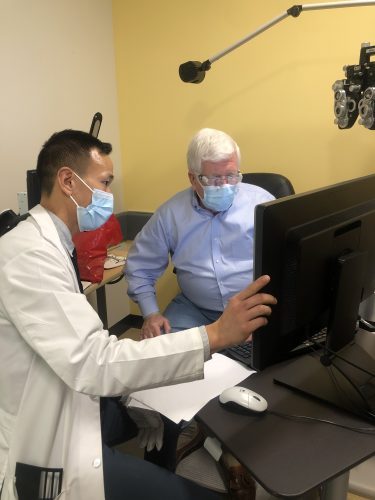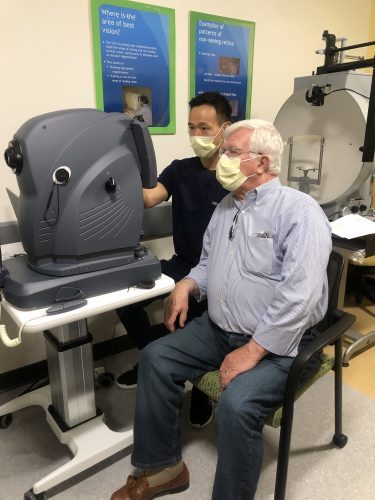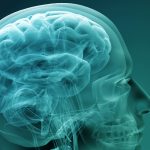Low vision affects nearly 14 million Americans and can result from disease or injury to the eye or brain. Focus spoke with optometrist and low vision specialist Patrick Lee, OD, FAAO, about the unique Vision Rehabilitation program at Mass Eye and Ear and how it can help patients with vision impairments maximize the use of their remaining sight.
Low vision can impact daily life
Low vision is a vision impairment that interferes with a person’s ability to complete daily tasks and can’t be corrected with conventional glasses, contact lenses, or other standard treatments like surgery or medications, Dr. Lee explained to Focus. Low vision can affect one or both eyes and the type and severity of the vision impairment varies. It can make it difficult to perform routine daily activities, like reading your phone or favorite book, seeing faces of loved ones, or even pouring coffee into a mug.
“One of the biggest challenges patients face is the ability to remain independent and complete daily activities,” said Dr. Lee. Even small difficulties like putting toothpaste on a toothbrush properly can have a big impact on a patient’s life. “Struggles with routine things around the house like reading the newspaper can be incredibly frustrating, and over time, a patient’s overall quality of life can diminish because of low vision.”
How vision rehabilitation can help

The goal of vision rehabilitation is to help patients maximize their visual function, understand the impact of their vision impairment, and develop a plan to meet their visual goals. Through the help of visual aids, lifestyle changes and strategies, and emotional support, Dr. Lee and his fellow vision rehabilitation specialists at Mass Eye and Ear work with patients to help them maximize their sight and maintain their independence.
“We develop a team approach with our colleagues in other ophthalmology and optometry services who are working tirelessly on diagnosing the underlying visual issue and, if possible, treating or stabilizing the disease,” Dr. Lee said. “Our goal is to understand how the diagnosis is affecting the vision of the patient and create a strategic plan to overcome it. We tailor the vision rehab process to each patient, depending on what the individual would like to accomplish.”
The typical vision rehabilitation process includes a detailed visual assessment, followed by a discussion of how the diagnosis affects visual function. The vision rehab specialist then works to develop an overall strategy catered to the patient’s visual goals.
Following the examination, the vision rehabilitation team collaborates with other clinicians and outside services that the patient may be eligible for due to his or her vision impairment, including occupational therapists, orientation/mobility instructors, social workers, driving rehabilitation specialists, and state/federal programs.
Low vision assessments, aids and resources
The vision rehabilitation team has a range of low-vision aids to help patients, including higher-powered reading glasses, magnifiers, telescopic lenses, tinted filtered lenses, and more advanced technologic electronic devices including optical character reader (OCR).
They also guide patients on lifestyle and work changes to help them function more comfortably in their daily lives. These changes can be as simple as moving the placement of furniture or lighting at home to avoid tripping, to providing written accommodation strategies to enable them to manage work tasks.
One of the biggest concerns for patients with low vision is being able to continue driving, as it’s a major part of their independence. The vision rehab team can assess a patient’s vision for driving safety with special testing including the Goldmann Visual Field test, and, if applicable, offer vision aids to allow him or her to keep driving. “If a patient is advised to give up driving, we will help find alternative means of transportation, including free community programs that offer local transport,” said Dr. Lee. “The safety of our patients is our key goal when discussing driving.”
An innovative diagnostic tool used in vision rehabilitation is the state-of-the-art Nidek Microperimeter (MP-3) machine, which provides a more thorough assessment of visual function. This new tool can help determine exactly where in the eye a patient is experiencing vision. “This is a unique diagnostic tool, and not every ophthalmology/optometry department has one in-house. We’re excited to be able to offer this technology to our patients to help maximize their sight,” said Dr. Lee.
Dr. Lee and his colleagues also work to help address the emotional issues that may come with low vision, like anxiety and depression. “It’s a common response to have some feelings of worry when things that you used to do with ease become difficult or seem impossible because of your vision impairment,” he explained. “We have a great network of support groups, social workers, and counselors that we work with directly in order to help our patients cope with these unexpected changes in their lives.”

When and how to seek vision rehabilitation
Dr. Lee recommends considering vision rehabilitation as soon as your vision impairment begins impacting daily life or activities, even if it seems minor. An eye care specialist can speak to vision rehab/low vision options, or patients may seek out assistance directly through the Vision Rehabilitation Service at Mass Eye and Ear.
“Many of our patients have been referred to us by our ophthalmology/optometry colleagues, both here at Mass Eye and Ear and at other hospitals across the region and world,” explained Dr. Lee. “If you struggle with anything due to your vision impairment, ask your eye doctor about low vision services.” The Vision Rehabilitation Service offers phone consultations to help determine the appropriate times to seek care, followed by an in-person assessment.
Dr. Lee also stressed the importance of regular eye exams with an optometrist or ophthalmologist, who can sometimes diagnose an eye problem before a patient’s vision becomes impaired.
“No matter your age, everyone should seek an annual eye exam as part of their basic healthcare assessment,” he said.
To learn more about vision rehabilitation at Mass Eye and Ear, visit the Vision Rehabilitation website or call 617-573-4177.
About Our Expert
 Dr. Patrick Lee is a low vision optometrist in the Optometry and Vision Rehabilitation Service at Mass Eye and Ear. He specializes in helping patients with vision loss due to eye disease or neurological injury and provides special visual aids, strategies, and therapies to allow the highest possible level of visual function. Dr. Lee sees patients at our Main Campus in Boston.
Dr. Patrick Lee is a low vision optometrist in the Optometry and Vision Rehabilitation Service at Mass Eye and Ear. He specializes in helping patients with vision loss due to eye disease or neurological injury and provides special visual aids, strategies, and therapies to allow the highest possible level of visual function. Dr. Lee sees patients at our Main Campus in Boston.




I was referred to you by Dr. Nouri, and will be in Boston the first week of September and would like to have an appointment to see you.
Hi Leslie, you can call 617-573-4177 to make an appointment with Dr. Lee or a member of our vision rehabilitation team. Thanks!
I would like to look at low vision aids. Do you sell them online?